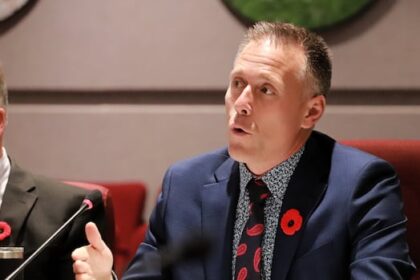ManitobaA half-dozen bus stops have been moved, some schedules are being adjusted and bigger buses are being added to one route to address concerns that have emerged following Winnipeg Transit’s recent route overhaul, the city says.No major changes coming in 1st year, but Transit has moved 6 stops, adjusted some schedulesOzten Shebahkeget · CBC News · Posted: Sep 11, 2025 12:15 PM EDT | Last Updated: 2 hours agoTweaks made to Winnipeg Transit service late last month include relocated bus stops and expanded on-demand service in some areas, as well as adjusted schedules for some routes to help buses arrive on time. (Rudi Pawlychyn/CBC)A half-dozen bus stops have been moved, some schedules are being adjusted and bigger buses are being added to one route to address concerns that have emerged following Winnipeg Transit’s recent route overhaul, the city says.Bjorn Radstrom, Winnipeg Transit’s manager of service development, says while no major changes are planned for the system before June 2026, people wrongly assumed that meant no changes would be made at all during the overhauled system’s first year of service.”We’re not making big changes — including where the routes go — but there’s a lot of other smaller things that we can do, such as adjusting the schedules, making slight tweaks to on-request service and changing the bus stop locations,” he said at a meeting of city council’s public works committee on Thursday.Winnipeg Transit launched its major route overhaul in late June, replacing its decades-old “hub-and-spoke” model, where buses meandered through outlying neighbourhoods before heading downtown, with a new “spine-and-feeder” system, under which buses follow a more grid-like pattern.The previous transit network had “fundamental flaws” that kept some routes from staying on time, the city said in a Thursday news release. Bus operators have said they’ve found the new routes easier to drive and to keep on schedule, according to the city.But since the changes, the city has had a wave of feedback from riders, most of which has been negative. That’s included complaints about longer trips, packed buses and stops that are too far apart.On Thursday, the city said it made changes late last month, as Transit’s fall schedule launched, in response to some of that feedback. September is always a time of full buses on Winnipeg roadways, but ridership tends to drop in October and November as people settle into their schedules, said Bjorn Radstrom, Winnipeg Transit’s manager of service development. (Prabhjot Singh Lotey/CBC)That includes moving six bus stops to make them easier to access, the city’s news release said.To prevent overcrowding, articulated or “bendy” buses were added to Route F8, which runs from Pembina to Henderson Highway. The route didn’t have any articulated buses previously, but Radstrom said four will now run in the morning and in the afternoon.More buses are also being added in six of the 12 zones of the on-demand transit service — south St. Vital, Sage Creek/Windsor Park, Waverley West, and Whyte Ridge/west Fort Garry, as well as zones in the city’s northwest and northeast.Schedules were also adjusted to improve bus routes D12 (Ellice), D13 (Sargent) and D16 (Academy-Notre Dame), which Radstrom said have been “the worst offenders for being late” since the overhaul.”What we’re working on is a complete rewrite of those schedules, so that the on-time performance is a lot better before December,” he said.Transit is also working on schedule changes for other routes that are consistently early — an issue that hasn’t been seen in a while, said Radstrom.”There’s things about the fall schedule that aren’t working as well as they want to, [and] we totally get that,” he said.”As much as we’d love to change that right away, we can’t implement those changes until the winter schedule goes into effect in mid-December, and that’s what we’re working on right now.”‘Horrible’ experience: riderBaraka Nyelele, a first-year education student at the University of Winnipeg, says her experience with the new bus system has been “horrible.””It takes so long for the buses to come, and when you think they’re coming, they’re cancelled,” she told CBC News at an Ellice Street bus stop on Thursday afternoon.Nyelele takes either the D12 (Ellice) or D13 (Sargent) buses to get downtown, but says she hasn’t seen a noticeable improvement in service since the fall schedule came into effect.”If the difference is them being slower and slower, then yes, I have.”Yana Tadessa, left, and Baraka Nyelele say they’ve had issues getting to the University of Winnipeg on time because of late buses. (CBC)She said she’s been basing her schedule on getting to school an hour before her classes start, in order to ensure she isn’t late because of bus delays.She’s even resorted to walking to school recently, saying the 20-minute trek can be quicker than a 30-minute wait for a bus.Yana Tadessa, who lives in the same area as Nyelele and takes the same routes as her friend, says late buses meant missing class early in the school year.”I get too scared to go into class [when late], and I kind of get embarrassed, so I just stay around the school since I came super late because of the bus.”Feedback can help pinpoint issuesSeptember typically sees full buses, Radstrom said — a pattern seen around the world. But ridership tends to drop in October and November as people settle into their schedules, he said.As of Thursday, the number of bus pass-ups — when a bus is too full to accept any more passengers — was about 10 per cent higher than the first 11 days of September 2024, but lower than for the same period in 2017, 2018 and 2019, according to Radstrom.”It’s not good that this is happening, but it’s a consistent pattern every year,” he said. “As a department, we’ve never [had the resources] to be able to eliminate the pass-ups from happening in September … and by the time we get to November, we would end up with too much service out there.”Transit continues to track feedback and monitor travel patterns, capacity and on-time performance, Radstrom said.While feedback shows Transit where to look for potential issues, it’s not a barometer for what’s a priority to change, he said.”You can get a situation where you’ve got a group of 30 people who’ve organized to all write in, [but] just because 30 people wrote in about that issue doesn’t mean that it’s more important than another one that only one or two people wrote about.”Feedback will contribute to short-term tweaks, while bigger changes will come down the road. Transit says it needs a full year to analyze travel patterns because people use public transportation differently during different seasons.After that, major changes will be made to the network regularly as part of Transit’s annual service plan process.Upgrades to bus stops and other operational infrastructure are also being finalized.The city also said Thursday that transit service has been fully restored for the first time since it was reduced due to a drop in ridership during the COVID-19 pandemic, meaning there are more buses and operators on the road now than in the last five years.Rider feedback fuels Winnipeg Transit tweaksFollowing public feedback about gaps in service, Winnipeg Transit has made some changes to its revamped network, including moving a half-dozen bus stops and adjusting some schedules.ABOUT THE AUTHORÖzten Shebahkeget is a member of Northwest Angle 33 First Nation who grew up in Winnipeg’s North End. She has been writing for CBC Manitoba since 2022. She holds an undergraduate degree in English literature and a master’s in writing.Email: ozten.shebahkeget@cbc.caWith files from Josh Crabb
Monday, 22 Dec 2025
Canada – The Illusion
Search
Have an existing account?
Sign In
© 2022 Foxiz News Network. Ruby Design Company. All Rights Reserved.
You May also Like
- More News:
- history
- Standing Bear Network
- John Gonzalez
- ᐊᔭᐦᑊ ayahp — It happened
- Creation
- Beneath the Water
- Olympic gold medal
- Jim Thorpe
- type O blood
- the bringer of life
- Raven
- Wás’agi
- NoiseCat
- 'Sugarcane'
- The rivers still sing
- ᑲᓂᐸᐏᐟ ᒪᐢᑿ
- ᐅᑳᐤ okâw — We remember
- ᐊᓂᓈᐯᐃᐧᐣ aninâpêwin — Truth
- This is what it means to be human.
- Nokoma











